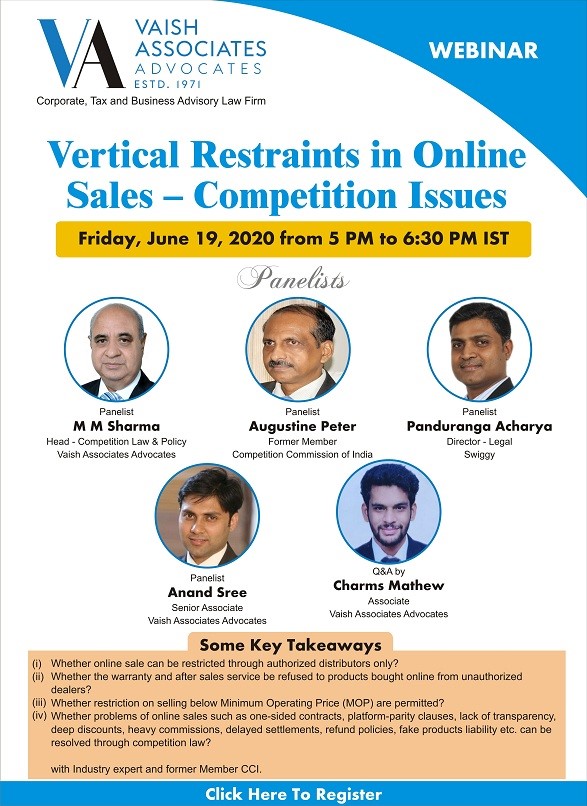WEBINAR ON “VERTICAL RESTRAINTS IN ONLINE SALES- COMPETITION ISSUES” -19TH JUNE 2020
While continuing to fight the Covid-19 Pandemic and working from home, like most other lawyers in India, knowledge dissemination has proved to be a silver lining. I decided to conduct a series of webinars on antitrust issues of larger importance. I am thankful to my Law Firm, Vaish Associates to agree to my suggestion and provided me the platform.
Accordingly, our second webinar in this series on “Vertical Restraints in Online Sales -Competition Issues” was held on 19th June 2020.
In the above webinar, I was joined by Mr Augustine Peter , IES (Retired) and former member of the Competition Commission of india (CCI), Mr Panduranga Acharya , Director (Legal) of India’s popular online food aggregator platform , SWIGGY and my team’s senior associate , Mr. Anand Sree .
I am reproducing hereunder the summary of the text of my power point (PPT) presentation during the webinar. The PPT presented during the webinar can be viewed in the video recording of the webinar here.
Caveat– As usual, I will have to begin with a legal disclaimer. Anything stated by us during the webinar does not constitute or is a substitute to a legal opinion and the views expressed are not necessarily the view of the Law Firm, Vaish associates but are personal views of each speaker. The webinar is organized for academic purposes as knowledge up dation program as part of our advocacy efforts
Efficient distribution of products and services remains one of the foremost concerns of any business. With the advent of internet, the online mode of sales and distribution, with its vast reach, is fast emerging as a popular mode of distribution in India as well and its importance has grown recently during the ongoing COVID-19 pandemic. This is why we decided to hold this webinar shortly after our last webinar on 5th June on exclusivity , in which , please recall that I briefly mentioned regarding the examination of numerous allegations of anti-competitive behaviour by some large e-commerce portals and the hardening of stance of the fair trade regulator , the CCI and the courts.
Benefits of e-commerce–
Selling online or e-commerce appears to be a road to future prosperity -delivering waves of innovations, efficiencies for the suppliers and consumer welfare at the same time. For sellers it reduces marketing costs and risks, provides safe environment for transactions online and reduces transactional delays thereby facilitating faster sales widens consumer base and brings economies of scale. For consumers, it offers wider choice of better-quality products and services at cheaper prices and brings transparency and provides comfort of home shopping. No doubt buying online is fast becoming the preferred mode of buyers across the globe, especially the younger generation, due to the “facade of abundance” available on the internet, and the choices being just a “click away”. E-commerce seems to have introduced real competition in markets due to the above said and has made the consumer as the king!
So no wonder most businesses want to include online selling in their market strategies. However, traders selling online face some common practical problems when they deal with any of the known e platform, such as one-sided contracts, delayed settlements, heavy commissions, lack of transparency, refund policies, fake products liability etc. In this webinar we will try to explain the origin and main reasons behind these common problems of the sellers and to see if they can be resolved under the competition law, with our Industry expert. We will also discuss other problems related to online distribution such as honoring of warranty, deep discounts, platform parity clauses, surge in ranking of preferred sellers etc. in this webinar with expert views Mr Augustine Peter, former Member, CCI.
Slide 6- E-commerce -Potential untapped
There is huge potential for growth of online mode of sale in India. India’s internet economy is expected to double from US$ 125 billion as of April 2017 to US$ 250 billion by 2020, majorly backed by ecommerce. India’s E-commerce revenue is expected to jump from US$ 39 billion in 2017 to US$ 120 billion in 2020, growing at an annual rate of 51 per cent, the highest in the world. However, out of estimated the 600 billion USD retail market in India, the share of revenue from e-commerce is only around 6-7% (approx. USD 38.5 billion in 2017). Despite a huge number of internet users in 2019, i.e. 665 million (expected to grow to 829 million by next year), the total online shopping was by around 50 million and of these 50 million e-shoppers, monthly purchases were by only 20 million e-shoppers . 70% of these online shoppers are below 25 years! This means the e-shopping is fast emerging as the preferred mode by the millennial generation and these is huge potential for growth of this demand. Reasons for underutilization of potential of online sales is mainly due to market inefficiencies including under development of our largely unorganised logistic sector!
Slide 7 – e-commerce players in India
Before I discuss the features of e-commerce , let us also note that e-commerce , as we understand from a common man’s point of view , means online sales in the 4 broad categories (i) goods/products and services category or the FMCG sector (where e-retailers like Amazon, FlipKart , Snapdeal , IndiaMart, BookMyShow, Myantra , PayTm eMall etc exist and compete with each other) , In the Insurance sector , we have price comparing websites like Policybazar etc. (ii) Online Travel Agents for Hotel and Tickets (both air and Railway) bookings ( where likes of MakeMyTrip, GoIbibo, Yatra, Cleartrip , easemytrip, PayTm , OYO etc. in the private sector compete with IRCTC in the public sector and also with International giants like Expedia, Bookings. com , as well as with price comparing website like , TripAdviser , TravelGuru , Trivago etc.) and (iii) Food delivery aggregators (Like Zomato, Swiggy , UberEats, FoodPanda (now acquired by OLA) , PIzzaHut Delivery , Dominos etc) and lastly, (iv) Taxi /cab booking aggregators ( Like Uber, Ola , Meru Travels, Fast Track Call Cabs etc) . However, due to limited time, we will be focussing only on the first 3 broad categories only and will just briefly touch upon the taxi aggregators issues.
Slide -8
Table 1: Large Digital Businesses and Their Platforms
| Microsoft Windows, Bing, Azure, | $946.5
|
| Apple iOS including App Development Platform and App Store | $961.3 |
| Amazon.com Amazon Marketplace, AWS | $916.1 |
| Alphabet Android (including Google Play), Google, YouTube | $863.2
|
| Facebook Facebook, Messenger, Instagram, WhatsApp | $512 |
| Alibaba Taobao, Tmall, AliExpress | $480.8 |
| Tencent QQ, WeChat, Tencent Games | $472.1 |
Slide 9
How vertical restraints in e-commerce affect competition
Legally speaking, when we talk about vertical restraints in e-commerce, we are speaking about same issues as we notice in physical sense i.e. exclusive supply and distribution agreements, resale price maintenance, tying up, refusal to deal. We discussed exclusivity in our last webinar in some details. The substantial law of competition analysis of vertical restraints of both price related ( e.g. re-sale price maintenance ) or non-price or “dealing restrictions” including both types of exclusive restrictions , remains the same i.e. such restraints are harmful only when the parties involved have significant market power or in dominant position and when they possess ability to foreclose the market .
Under the Indian Competition Act 2002 , the vertical restraints can either be examined under Section 4 for abuse of dominant position or under Section 3(4) of the Act under the rule of reason analysis to see if the particular restraint causes AAEC in the relevant market . But to understand them in the context of the digital economy or virtual e-commerce, we first need to understand the unique features of the e-commerce model.
Slide 10 – Unique features of e -commerce
Let me now come to the special features of the online sales or e-commerce which makes the dynamics of competition in digital markets different than those in normal physical markets. Please keep in mind that online sales are preferred mostly by online retailers with less brand equity compared to traditional stores chiefly because it takes time to build reputation and good will and e-retailers are relatively new businesses. Most important is the prominence of intermediaries, most of which are multisided platforms, with strong indirect network effects and the implications of the Internet and other information technologies tools, including use of big data and algorithms by these intermediaries to create their unique platform governance /ecosystem thereby creating a sort of “private competition” within the platform , characterized by information asymmetry and opacity ( non-transparent) between the platform and both sides of the users , i.e. buyers and sellers , leading to market inefficiencies ( referred to as problem of adverse selection) and use of the same to sometime destroy platform neutrality by self-preferencing in favour of its related sellers to the disadvantage of other non-related sellers wanting to use the platform . The use of big data for data harvesting through algorithms to influence user choices etc., to enforce personalised and discriminatory pricing with targeted advertisements. In the context of vertical restraints antitrust issues arise from the application of platform rules for participation, exclusive contracts, and Most Favoured Nations (MFN) clauses, or the Across platform parity agreements (APPA), used mostly in online hotel bookings and food delivery platforms.
As stated above , the foremost core antitrust issue concerns e-commerce is situations in which the platform also operates a business on one side of its platform and in which the platform has allegedly used its governance system to raise rivals’ costs or exclude competitors on that side. This is now popularly known as self-preferencing or preferred sellers or private labels etc, which are sellers related to the e-platform , which is given surge in rankings or offers deep discounts , which can not be matched by other online sellers featuring on the same platform. These are basically exclusivity issues, which we discussed in the last webinar. This affects
In most cases, these intermediaries follow a traditional reseller model in which buyers interact directly with the intermediary rather than with sellers. Please note the difference between a “platform” and a “reseller’. Roughly speaking a shopping mall is platform while a department store is a reseller. Thus “digital multisided platforms” can be described simply as “digital platforms” and digital intermediaries that follow a reseller model as “digital resellers”.
The big question is -Do we understand the problem? Have the e-platforms remained “platforms” in true sense or have these digital platforms remained neutral? which was perceived by public to be their original purpose or have they transformed into digital resellers and whether this transformation is hurting competition? In my view, Yes. Due to the strong market power derived by these digital resellers, due to indirect network effects, coupled with use of the big data for harvesting it with use of advanced analytics, i.e. smart algorithms , which can predict and influence end users purchasing behaviours , while still mimicking themselves as e-platforms , they have tried to have best of both worlds , by influencing buyers choice on one hand due to use of smart algorithms and by exploiting and (sometimes excluding ) sellers on the other hand due to their one sided contracts , including parity clauses , heavy commissions , non-transparent policies etc. due to information asymmetry caused by their uniquely designed and controlled ecosystems or governance structures . By their unique business models , of forgoing profits to expand exponentially , these platforms have created a “private competition“ within their echo system with non-transparency and distortions as the key and have created what Ms Margret Vestager , the EU Commissioner has rightly described as “The Centres of large empires”! Due to their strong market powers these e-platforms can use and do use all sorts of vertical restraints to soften inter brand competition. They frequently use advanced analytics i.e. algorithm to impose vertical restraints including resale price maintenance (RPM) and exclusive arrangements with its preferred sellers thereby promoting hub and spoke cartels.
But the big problem faced by Antitrust authorities is (a) how to define relevant market in cases of online sales to determine whether the e platform has acquired significant market power or dominant position in the relevant market. Whereas an over intervention can kill a dynamic market and an under intervention can damage fair competition and allow exploitation and exclusionary practices to continue, which is against both consumer welfare and allocative efficiencies. In India, CCI has also faced and continues to face this problem.
Slide 11-12
Main Competition issues in e-commerce
- Use of exclusive clauses by dominant platforms[1] to harm competition with a rival platform (horizontal foreclosure). It emphasizes two aspects that are particular to digital platforms: the use of exclusives to prevent rivals from securing or maintaining critical mass or the benefit of indirect network effects; and the role of algorithms in securing loyalty (single-homing) by some participants. [Alibaba’s use of exclusive contracts for sellers on its T mall property in China provides an example. – “Cat & dog War” in China. – Page 24-26[2]]
- Use of exclusive clauses by dominant platforms with business interests/stakes in some preferred sellers or related entities or subsidiaries selling goods or services , to indulge in self-favouritism by surging their rankings on the platforms and also by giving deep discounts to attract more buyers, which can be matched by ordinary online sellers on the platform . Besides this helps them prevent Multi Homing [in EU –Google Search (Shopping) case AT.39740- Google gave its own comparison-shopping service an illegal advantage. In USA-Amazon & Apple Investigations. In India- CCI order dated 13.1.20 under Section 26(1) against Amazon and FlipKart -stayed by Karnataka High Court on 14.2.20]
- Use of platform governance system or ecosystem by dominant platform* to raise rivals’ costs, or exclude, a participant on the side that competes with the platform’s own service on that side. [Apple’s alleged use of its app developer rules to impose
limitations on Spotify, which competes with Apple Music, provides an example-“Music Wars “—Page 29-32(ibid)]
- Use of MFNs by digital platforms with substantial market power* or by Price Comparison Websites- (also called as Across Platform Parity Agreement (APPA) or “Wide Parity” clause or “MFN Plus” -which applies separately to price and commission. The across-platforms parity agreements (APPA) may result in removal of the incentives for platforms to compete on the commission they charge on hoteliers, may inflate the commissions and the final prices paid by consumers and may also prevent entry of new low cost platforms. We can discuss in detail if time permits. [Anand Sree to explain in detail with examples] (Page 33-34)-[ Apple e-books case (2012),Amazon’s Case in UK(2013);Amazon ‘s Case in EU (2015); HRS Case (2013) in Germany;Bookings.com(2015); Blue Cross Blue Shield of Michigan (BCBSM) case in USA (2011) ; Credit cards case in USA (2010); In India -Ongoing investigation against MakeMyTrip and OYO-vide CCI orders dated 28.10.19 and 24.2 20 under section 26(1)].
- Digital collusion- Use of algorithms to collude on prices or indulge in RPM [ Casio case (2019) in UK-GBP 3.7 Million Fine-recommended price became de facto resale price maintenance; 2018 –EU Commission Decision in re Asus, Denon, Marantz, Philips, Pioneer]: Use of AI to indulge in horizontal collusion/cartel – In USA-[Airline Tariff Publishing, Topkins, Trod Cases ] ; Use of AI to indulge in Hub and Spoke cartels– [Dynamic pricing by Uber and Ola etc according to time -intentional alignment of prices ; Eturas (2016)-Poster & Frames price fixing case ; Dynamic personalized pricing -e.g.a2i system – a2i systems (short for applied artificial intelligence systems) is a full stack vertical AI company solely focusing on developing Price Cast Fuel – the world’s only AI-first industry-specific retail fuel pricing decision and optimization system.]
Slide 13
Efficiency justifications unique to e commerce
Read the slide (Source OECD Policy Roundtables on “Vertical Restraints in On-Line Sales”) (Page 17-19)
Slide 14
CCI Market Study on E commerce in India
As some of you may be aware that on 08 January 2020, the CCI published the “Market Study on E-commerce in India: Key Findings and Observations” (“Market Study”) encapsulating the findings and results of the investigation. The Market Study covers E-Commerce in the segments of (i) consumer goods (mobiles, lifestyle, electrical and electronic appliances, and grocery); (ii) accommodation services; and (iii)food services.
The Market Study observed that the imbalance of bargaining power, and information asymmetry between e-commerce platforms and business users, are at the core of the competition law issues concerning the E-Commerce market. The competition law issues highlighted in the Market Study are
- Platform neutrality– Preferential treatment of platform’s own or related entities.
- Platform-to-business contract terms– Unilateral revision in contract terms and imposition of unfair/one-sided contract terms;
- Platform price-parity clauses– Restriction of sellers/service providers from offering their goods or services at lower prices on other platforms (i.e. wide parity) or on the seller/seller provider’s own website (i.e. narrow parity);
- Exclusivity Agreements– Agreements where a certain product is launched exclusively on a single online platform, as well as, agreements where a platform lists only one brand in a certain product category: and
- Deep Discounts– Platforms funding price discounts for products listed on the platform.
Based on the said findings, the CCI directed course correction in the E-Commerce market in the form of self-regulatory measures to reduce information asymmetry and positively influence competition outcomes.
Slide 15-16
The self-regulatory measures indicated by the CCI are as follows:
Search Ranking –The main search ranking parameters are to be set out in the user terms and conditions, in intelligible and unambiguous terms. If there is a possibility of the search parameters being influenced by any direct or indirect remuneration paid by users, the marketplace platforms are to set out a detailed description of those possibilities and the effects of such remuneration on ranking. However, any such disclosure should not enable the manipulation of search results by third parties.
Collection use and sharing of data – Platforms are to formulate a transparent policy with respect to collection and usage of data. The policy should also include the potential and actual sharing of such data with third parties or related entities.
User review and rating mechanism –Platforms to maintain transparency in publishing and sharing user reviews and ratings with business users. Ratings and reviews are to be authentic and mechanisms must be devised to prevent fraudulent reviews/ratings.
Revision in contract terms- Prior notice to be given to users in case of any proposed changes to the terms and conditions. Any proposed changes are to be implemented only after the expiry of a notice period. Such notice period must be reasonable and proportionate to the nature and extent of the envisaged changes, and their intended consequence for the user.
Discount policy-Platforms are to be clear and transparent with respect to their discount policies. The discount policy should, amongst other things, specify the basis of the discount rates funded by the platforms for different products/suppliers and the implications for business users’ participation/non-participation in discount schemes.
Slides 17-19- Legal framework under Competition Act, 2002 –
Slide 20 -Issues examined in India –– “India Story so far”
I discussed the cases decided in India so far on vertical restraints in e commerce.
Slide 21-28-
I discussed some practical issues of online selling and how CCI has decided them to give the much-needed clarity for the businesses.
- Issue 1: Online sale restricted through authorised distributors only + Restricting the warranty and after sales service to products bought online from authorized distributors only – Permitted. [Ashish Ahuja v Snapdeal.com & Anr.]
- Issue 2. Refusal to give warranty on goods sold by unauthorised dealer online- Permitted. [M/s Counfreedise v Timex Group India Ltd]
- Issue 3. Exclusive agreement for online sale of selected products exclusively on the selected e-portal-Permitted. [Mohit Manglani v Flipkart & Ors]
- Issue 4. Total ban on online sale and sale outside designated sales region by authorised distributor -Permitted. [M/s K C Marketing v OPPO Mobiles MU Private Limited]
- Issue 5. Refusal to allow online sale on a e-portal due to deep discount + Refusal to give warranty on products sold through the particular e-portal -Permitted [Jasper Infotech Private Limited (Snapdeal) v KAFF Appliances (India) Pvt. Ltd] .
- Issue 6. Total ban on online sale by authorized sub distributors-Permitted [M/s Karni Communications v Haicheng Vivo Mobile (India) & Ors]
- Issue 7. Ban on sale outside designated sales region by authorised distributor through strict Market Infiltration Policy (MIP). [ M/s Karni Communications v Haicheng Vivo Mobile (India) & Ors]
- Issue 8. Restriction on selling below Minimum Operating Price (MOP). [ M/s Karni Communications v Haicheng Vivo Mobile (India) & Ors]
Slide 29-31-Recent developments in some important cases on e-commerce
Slide 29- Before I discussed the better known cases of Amazon and FlipKart , as promised , I discussed briefly on Taxi aggregators cases .
- Taxi/ Cab aggregators cases- These cases do not strictly fall within our topic of vertical restraints but relate to allegations of predatory pricing /abuse of dominant position. But still I am giving a brief overview since they also relate to e-commerce platforms like Uber, Ola.
[ CCI received as many as 10 cases in radio taxi industry by the Commission involving allegations regarding unilateral conduct. These have been filed by the traditional radio taxi players against online cab-aggregators (Ola and/or Uber) alleging abusive low pricing strategies (predatory pricing) by the online cab aggregators which allegedly the former were not able to match because of the high capital investment in the owned fleet. Most of these cases were closed at the prima facie level as the CCI did not find any of the cab-aggregators to be dominant in the relevant market and in the absence of dominance, an enquiry with regard to abuse could not have been looked into as per the scheme of Competition Act, 2002.
However, one case concerning abuse of dominant position by a domestic cab aggregator (namely, ‘OLA’) in the relevant market of Bengaluru (a city in Karnataka) was sent for investigation. The DG, after detailed investigation, was of the view that OLA does not hold a dominant position in the relevant market because of the presence of competitive constraints posed by UBER (a global cab aggregator). It was further noted that in two-sided markets, network effects may enable a large platform/network to become dominant and insulate itself from potential competition as entrants may find it difficult to challenge the large incumbent. However, there can be certain countervailing market forces that reduce the ability of even a very large platform to insulate itself from competition. CCI noted that despite OLA having the largest network, the network effect was not strong enough to deter entry and rapid expansion of other big competitor ‘UBER’ who was competing fiercely with OLA. Further, there were no significant costs preventing consumers from switching between different radio taxi apps. The radio taxi apps are offered for free and can be easily downloaded on smartphones and can coexist on the same handset, thus, multi-homing was found to be possible for both drivers and riders. The CCI vide its order dated 19.72017 also noted that the competition in the relevant market was still unfolding and decided not to interfere in a market which is yet to fully evolve. Appeal filed before NCLAT by the Informants on 02-09-2019 is pending.
However, there is one case against Uber which deserves a mention. This case was filed against Uber in the Delhi-NCR market (Meru Travels Pvt. Ltd. Vs Uber11). Though the Commission closed the said matter at the prima facie stage, the appellate authority (i.e. erstwhile COMPAT) referred the matter to Director General for investigation. However, pursuant to an appeal filed by Uber against the said order of the erstwhile COMPAT, the Hon’ble Supreme Court initially issued a stay on investigation. However, Supreme Court finally dismissed the appeal of Uber vide judgment dated 3.9.2019 and directed investigation against Uber’s alleged “predatory pricing” because of the single evidence produced by the Informant before CCI showing that UBER was losing Rs. 204/- per trip, which was considered sufficient by the Hon’ble Court as indication of predatory intent of Uber. The Supreme Court did not bother to go into the complicated competition law issues such as whether Uber was dominant in the relevant market or not , which is a sine qua non for prosecution for predatory pricing under Section 4 of the Act.
Slide 30-31
Slide 30-
Cases filed against Amazon /FlipKart (by Delhi Vyapar Mahasangh) (“Informant”) – a society consisting of Micro, Small and Medium Enterprises (“MSME”) traders of smartphones and related accessories who list their products on the e-platforms. CCI vide its order dated 13.01.2020, directed the Director General (“DG”) to investigate whether the alleged exclusive agreements, deep-discounting and preferential listing of a few select sellers by Amazon and Flipkart on their respective platforms is being used as an exclusionary tactic to foreclose competition and resulting in an Appreciable Adverse Effect on Competition (AAEC). This order marked a big shift in the CCI’s policy towards e-commerce platforms, as noticed from its decision in the Taxi aggregators cases and earlier cases decided against other e-platforms wherein it had adopted a soft glove treatment to e-commerce as an evolving market for the benefit of consumers . Interestingly, the CCI avoided defining the relevant market in this case ostensibly on the basis of Supreme Court Judgement in Excel Corp Case. Moreover, CCI has played safe by avoiding going into the allegation of joint dominance or collective dominance of both Amazon and Flipkart since the concept of collective dominance is still alien to Indian Competition Law. The reference for investigation under Section 3(4) of the Act makes it mandatory for the Commission to apply “Rule of Reason” analysis in which it will inevitably have to consider the counter arguments of the e-commerce platforms in the final analysis. However, this prima facie order was challenged in Karnataka high Court and the High Court vide its order dated 14.2.2020, has stayed the said prima facie order of CCI directing investigation by the Director General (DG). Since the matter is sub judice we will avoid making any comments.
Investigation directed by NCLAT against FlipKart –[by allowing appeal filed by the All India Online Vendors association (AIOVA)]. NCLAT vide its order dated 04.03.2020, set aside the order dated 06.11.2018 passed by the Competition Commission of India (“CCI”) dismissing allegations of Abuse of Dominant Position by Flipkart India Pvt. Ltd and Flipkart Internet Pvt. Ltd. Made by the AIOVA, a group of more than 2000 sellers selling on e-commerce marketplace such as Flipkart, Amazon, and Snapdeal etc. The primary allegation was self-referencing by FlipKart in favour of WS Retail Services Private Limited (“WS Retail Service”), which was owned by the founders of Flipkart Internet Pvt Ltd.( FlipKart Internet) till 2012, by first selling goods to WS Retail Service, at a discounted price and thereafter, these goods are sold on the platform operated by Flipkart. I am sure that an appeal will be filed by FlipKart challenging this order of NCLAT in Supreme Court. Since the matter is sub judice I will avoid making further comments.
Slide 31–
Investigation against MMT and OYO- As stated above , CCI, till as recent as October 2019, adopted a soft glove treatment by considering online sales as a substitute/alternative to offline/physical stores sales and not as a separate market and dismissed most allegations. However, vide its order dated on 28th Oct 2019 for the first time , CCI considered the market for online travel bookings of hotels in India as a separate relevant market and finding that Make My Trip as dominant e-portal in such market has directed investigation not only against its unilateral conduct of allegedly enforcing exclusivity on hotels availing its booking services under section 4 but also against MMT’s exclusive arrangement with OYO for bookings of budget hotels to allegedly exclude its (OYO’s) competitors , Treebo and Fab Hotels. Again, vide another order dated 24th February ,2020, CCI directed another investigation against MMT on a complaint filed by Treebo Hotels for allegedly removing it from MMT platform and inducing it to accept exclusivity obligations including “wide parity” like other hotel partners as a condition to get listed again. Since the investigation is on., I will not make any further comments.
Practical common problems of vendors
Now towards the end of my presentation , I discussed some practical issues faced by vendors who wish to turn to online selling through the e-platforms, in general and let us see if these are competition issued per se or if not is there any solution . I referred to a new experiment on the anvil in India , the Digital Mall of Asia , (DMA) started by one of my Rotary Friends , Mr Rishab Mehra ( and we advised him on legal issues such as Licence agreements foe vendors booking shops on the e-platform. I explained that in this new emerging concept how the DMA remains like a physical shopping mall, not interfering in any manner with the vendors and their dealings with their online shoppers. DMA, unlike most large e-platforms (Amazon et al) does not receive money from the online buyer , does not undertake delivery of products etc or refund etc. and like a normal physical Mall, it is concerned only with taking license fee from the vendors displaying goods on the DMA . The payment is made by the online buyer directly to the vendor either online or offline (through Cash on Delivery option also available) and goods are also delivered directly by the vendor from its physical shop in the city ( a mandatory condition for taking e-shop on licence in DMA). DMA works on zero commission model. Thus all problems of online vendors, such as , one-sided contracts, delayed settlements, heavy commissions, lack of transparency, refund policies, fake products liability etc.seem to vanish in this new model. The platform neutrality is restored!! Though it is not strictly a competition issue but this new model , in my view , seems promising and whether it can emerge as a viable alternate to the existing and prevalent models of e-platforms based on the commission model remains to be seen in future!
Slide 32 -35 (By Anand Sree) – Apprised our viewers with some issues which are still new to India but decided in foreign jurisprudence, which may influence decisions in India on these issues as well.
Slide 36-37 (Augustine Peter) – For media coverage on his speech and answers to the questions, and related discussion held in the panel, please see the video recording . You may also like to read the report from PaRR here.
Slide 38-39 (Panduranga Acharya) – For media coverage on his speech and answers to the questions, and related discussion held in the panel please see the video recording. You may also like to read the report from PaRR here.
[1] A successful anticompetitive strategy can harm both buyers and sellers. To begin with, both lose the opportunity to multi-homing on several platforms—options they would presumably have in the absence of exclusive contracts. Multi-homing intensifies competition along nonprice dimensions such as service and discovery mechanisms. The exclusivity agreements can also raise prices. By limiting competition, the dominant platform can increase the commissions.it charges sellers for distribution on its platform. Those sellers may pass some, or possibly all, of those increased commissions back to consumers in the form of higher prices.
[2] Vertical Restraints in a Digital World -by David S Evans, 22 March 2020








